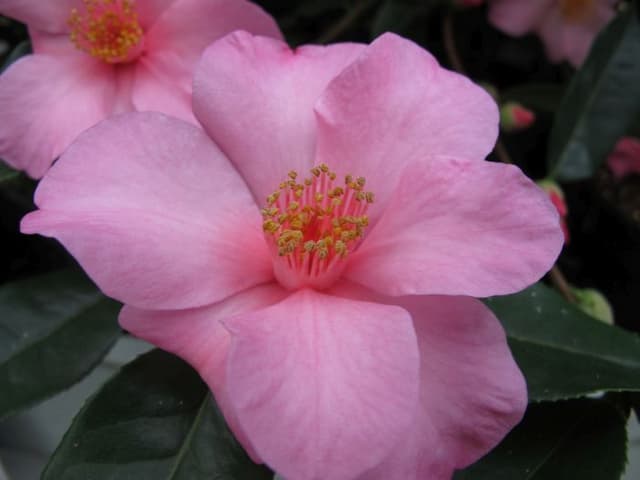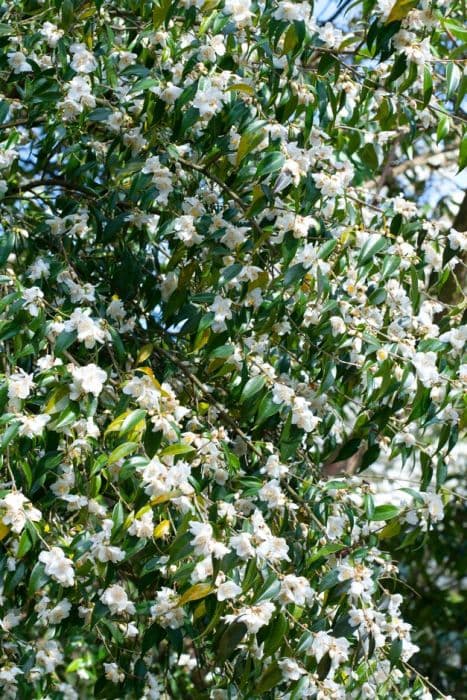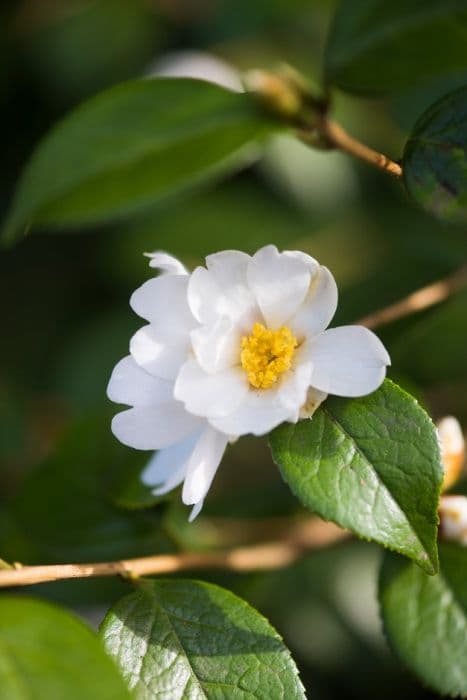Japanese camellia Camellia japonica 'Scentsation'

ABOUT
Camellia japonica 'Scentsation' is notable for its exceptionally fragrant, large flowers which come in a soft yet vibrant shade of pink, adding a touch of elegance to any garden setting. The plant typically blooms in the late winter to early spring, providing a burst of color when few other plants are in flower. The blossoms are notably lush and have a peony-like form with multiple layers of delicate, rounded petals that gracefully unfurl from the bud. Each flower is accented in the center with a group of contrasting golden-yellow stamens, creating a beautiful focal point amidst the glossy, deep green foliage. The leaves of this plant are equally attractive, presenting themselves as oval, leathery structures with a subtle serration on the edges giving a slightly toothed appearance. These evergreen leaves maintain their rich color throughout the year, ensuring that the plant remains a vibrant backdrop for its spectacular blooms. The growth habit of 'Scentsation' is upright and compact, with well-branched stems that create a full and bushy appearance. The overall look of the plant is one of tidy elegance, with its lustrous foliage complementing the exquisite, sweet-scented flowers which are the true stars of the show.
About this plant
 Names
NamesFamily
Theaceae
Synonyms
Japanese Camellia, Camellia, Rose of Japan
Common names
Camellia japonica 'Scentsation'.
 Toxicity
ToxicityTo humans
Camellia japonica 'Scentsation', commonly known as Japanese camellia, is not considered toxic to humans. There are no significant symptoms of poisoning associated with this plant since it is not listed as a poisonous plant for human ingestion. Therefore, accidental consumption is not expected to result in any adverse health consequences.
To pets
Japanese camellia is also generally considered non-toxic to pets such as dogs and cats. It is not known to cause serious illness or poisoning if pets ingest parts of the plant. As with any non-food item, ingestion of large quantities might cause mild gastrointestinal discomfort, but toxicity symptoms specific to this plant are not expected.
 Characteristics
CharacteristicsLife cycle
Perennials
Foliage type
Evergreen
Color of leaves
Green
Flower color
Pink
Height
6-10 feet (1.8-3 m)
Spread
5-7 feet (1.5-2.1 m)
Plant type
Shrub
Hardiness zones
7
Native area
Japan
Benefits
 General Benefits
General Benefits- Ornamental Value: Camellia japonica 'Scentsation' is prized for its showy, fragrant flowers that enhance garden aesthetics.
- Year-Round Interest: It offers glossy, evergreen foliage providing visual interest even when not in bloom.
- Shade Tolerance: This plant can thrive in partially shaded conditions, making it suitable for underplanting beneath taller trees.
- Drought Resistance: Once established, it has a degree of drought resistance, requiring less frequent watering.
- Low Maintenance: It requires minimal pruning and is relatively easy to care for, which is ideal for gardeners of all skill levels.
- Long Blooming Period: The 'Scentsation' variety has a long flowering period, often from late winter to early spring.
- Versatility: Can be used in mixed borders, as a specimen plant, or for foundation plantings, offering design flexibility in landscaping.
- Wildlife Attraction: The flowers can attract pollinators such as bees, contributing to the health of your garden's ecosystem.
 Medical Properties
Medical PropertiesThis plant is not used for medical purposes.
 Air-purifying Qualities
Air-purifying QualitiesThis plant is not specifically known for air purifying qualities.
 Other Uses
Other Uses- Artistic Inspiration: Camellia japonica 'Scentsation' is often used as a subject in painting and photography due to its vibrant flowers and aesthetic appeal.
- Culinary Garnish: The petals of Camellia japonica 'Scentsation' can be used to garnish salads and desserts, adding a splash of color to dishes.
- Textile Dyeing: The petals can also be used to create natural dyes for fabrics, giving a soft pink to beige hue.
- Wedding Decor: Owing to its beauty and fragrance, it serves as an elegant option for wedding bouquets and decorations.
- Perfumery: Some cultivars of Camellia japonica are used in the production of perfumes, and 'Scentsation' may have potential in this industry thanks to its fragrance.
- Hair Accessory: In some cultures, flowers of Camellia japonica are used to adorn hair, adding natural beauty to hairstyles.
- Religious Ceremonies: Camellia japonica 'Scentsation' can be incorporated into floral arrangements for various religious events and ceremonies.
- Butterfly Garden Attraction: Planting Camellia japonica 'Scentsation' can help attract and support local butterfly populations.
- Theme Gardens: It can be used to create a 'romantic' themed garden space, due to its lush flowers and lovely scent.
- Tea Cozies: Dried Camellia japonica 'Scentsation' petals can be used to fill handmade tea cozies, providing a faint fragrance with each use.
Interesting Facts
 Feng Shui
Feng ShuiThe Camellia is not used in Feng Shui practice.
 Zodiac Sign Compitability
Zodiac Sign CompitabilityThe Camellia is not used in astrology practice.
 Plant Symbolism
Plant Symbolism- Adoration: The Camellia japonica 'Scentsation', commonly known as the Camellia, is often associated with deep adoration and admiration, making it a popular gift for those you deeply respect or hold dear.
- Perfection: Due to its perfectly formed petals and elegant appearance, the Camellia is seen as a symbol of perfection and is often given to convey the message of someone being flawless in the eyes of the giver.
- Longevity: The Camellia plant is an evergreen with a long blooming period, which symbolizes the wish for a long and prosperous life.
- Love: With its beautiful flowers, the Camellia also represents love and is given as a romantic gesture, particularly the red Camellia which is associated with deep passionate love.
- Refinement: The Camellia's sophisticated appearance expresses the idea of refinement and speaks to the beauty and elegant qualities of the recipient.
 Water
WaterFor Camellia japonica 'Scentsation', commonly known as Japanese Camellia, watering should be done thoroughly, allowing the top few inches of soil to dry out before the next watering. This will usually equate to watering once a week, but frequency may need to increase during hotter, drier periods. When watering, use enough water to moisten the soil deeply, which could mean roughly 1 to 1.5 gallons for a medium-sized plant depending on the size of the camellia and the environmental conditions. Avoid overhead watering to prevent leaf diseases; instead, water directly at the base of the plant.
 Light
LightJapanese Camellia thrives best in partial shade with some morning sun and afternoon shade. Avoid direct, harsh sunlight, as it can scorch the leaves. An ideal spot is under the canopy of taller trees where the plant can receive filtered light. Bright, indirect light will encourage healthy growth and flowering.
 Temperature
TemperatureJapanese Camellia prefers moderate temperatures, ideally between 60°F and 70°F. They can survive in temperatures as low as 20°F but not lower, and should be protected from frost. This plant may struggle in regions where temperatures frequently fall below this range or exceed 85°F, as extreme temperatures can affect flowering and overall health.
 Pruning
PruningPrune Japanese Camellia to shape the plant, remove any dead or weak wood, and encourage a strong structure. The best time for pruning is after the blooming period in spring, as pruning later can remove potential flower buds. Generally, pruning once a year is sufficient, but the plant can also be lightly trimmed throughout the year to maintain its shape.
 Cleaning
CleaningAs needed
 Soil
SoilThe Japanese camellia 'Scentsation' thrives in well-draining, acidic soil with a pH between 5.5 and 6.5. A mix of 1/3 organic matter such as pine bark or leaf mold, 1/3 peat moss, and 1/3 perlite or sand makes for an ideal soil mixture.
 Repotting
RepottingJapanese camellias like 'Scentsation' should typically be repotted every 2-3 years, or when they become root-bound. Early spring, just before the growing season begins, is the best time for repotting.
 Humidity & Misting
Humidity & MistingThe Japanese camellia 'Scentsation' prefers a humidity level of around 40-50%. It can tolerate higher humidity but good air circulation is necessary to prevent fungal diseases.
 Suitable locations
Suitable locationsIndoor
Place in bright, indirect light and ensure high humidity for 'Scentsation'.
Outdoor
Shelter from strong winds, partial shade, and mulch for roots of 'Scentsation'.
Hardiness zone
7-9 USDA
 Life cycle
Life cycleThe life of Camellia japonica 'Scentsation', commonly known as Japanese camellia, begins from a seed, which after germination, gives rise to a seedling with the initial pair of true leaves. As the seedling grows, it develops into a juvenile plant, forming a small bush with glossy, evergreen leaves. When the plant reaches maturity, it typically starts to flower during late winter to early spring, producing fragrant, showy flowers ranging in color from white to pink and red. After pollination, usually by bees or other insects, the flowers develop into dry capsules containing seeds, thereby completing the reproductive phase. Once the seeds mature, they are dispersed, potentially giving rise to new plants and continuing the cycle. As an evergreen perennial, this Camellia can live for many years, often several decades, continuing to grow and bloom annually.
 Propogation
PropogationPropogation time
Spring-Early Summer
Propogation: The Camellia japonica 'Scentsation', commonly known as Camellia, is best propagated through semi-hardwood cuttings. This method is popular because it generally ensures a good clone of the parent plant with identical characteristics. The most effective time to take these cuttings is in late summer after the blooms have faded, ensuring the wood has matured enough yet is not too hard. To propagate, a cutting of about 4 to 6 inches (10 to 15 centimeters) is taken from a healthy branch, making the cut just below a node. The leaves on the lower half of the cutting are removed, and the cut end is dipped in a rooting hormone to enhance root development. The cutting is then placed in a well-draining potting mix, kept moist, and covered with a plastic bag or placed in a propagator to maintain a humid environment. With the appropriate care, roots typically develop in several weeks to a couple of months.









